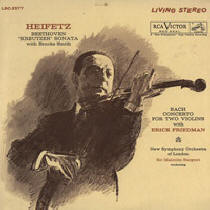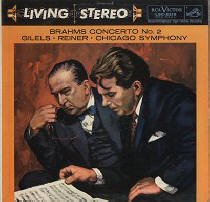|
You are reading the older HTML site Positive Feedback ISSUE january/february 2008
RCA Classical
Reissues on Vinyl by Cisco
RCA LSC-2577 - Beethoven "Kreutzer" Sonata with Jascha Heifetz and Brooks Smith and the J. S. Bach Concerto for Two Violins (BWV 1043) with Erick Friedman and Sir Malcolm Sargent conducting the New Symphony of London The "Kreutzer" Violin Sonata is the most famous of all of Beethoven's violin sonatas. This is primarily due to the emotion, the angst contained in the presto of the first movement. That first presto of the "Kreutzer" expresses Beethoven's despair and inner turmoil caused by his realization that he had lost his six year fight with deafness and that he would never hear again. Never before in chamber music had such depth of emotion, such agitation, been expressed. This presto would forever divide the old, refined, polite, aristocratic world of chamber music from the new world of emotions and feelings—of chamber music for the masses. One year later, Beethoven's Symphony No. 3, the "Eroica", would accomplished the same thing - introducing deeply felt emotions into symphonic music. By today's standards the depth of emotion expressed in the "Kreutzer" is not unusual. Thus, it is difficult for us to see the division of chamber music between the polite background chamber music of ‘before Kreutzer' and the emotionally involving chamber music of ‘after Kreutzer'. Beethoven wrote the "Kreutzer" in 1803. In 1889, Leo Tolstoy wrote a short novel entitled The Kreutzer Sonata . Tolstoy said regarding the "Kreutzer": "How can that first presto be played in a drawing-room among ladies in low-necked dresses? To hear that played, to clap a little, and then to eat ices and talk of the latest scandal? Such things should only be played on certain important significant occasions, and then only when certain actions answering to such music are wanted." Eighty-six years after the "Kreutzer" was written a non-musician like Tolstoy was able discern that there was something immensely different about the "Kreutzer" and the polite chamber music that was still being played at musical recitals. As the most famous of Beethoven's violin sonatas, the "Kreutzer" as been recorded many times over the years. On LSC-2577 you have the pairing of Jascha Heiftez, violin, and Brooks Smith, piano. There is no question that Heifetz was the most technically brilliant of all of the violinists recorded in the 20th century. His fans are legion and they will be immensely pleased with this new Cisco reissue. This is Heifetz at his jaw-dropping best with superb RCA sound. That being said, I had a discussion with Robert Pinkus at Cisco records regarding his choice of this particular recording of the "Kreutzer". Brooks Smith is not a Rubenstein, Ashkenazy, or Argerich. If you listen to the Szeryng/Rubinstein performance recorded by RCA a year earlier on LSC-2377 you readily hear the difference a great pianist can make to this sonata. Not that I particularly like the Szeryng/Rubinstein. Both LSC-2377 and LSC-2577 in my estimation lack the emotional impact that the presto demands. This is Beethoven. This is music that is meant to be felt in our inner core. To my taste, the 1973 Perlman/Ashkenazy on Decca/London or the 1998 Perlman/Argerich on EMI are more emotionally satisfying. However, that is just me. I am sure that others will agree with Robert that LSC-2577 is a wonderful performance. I will agree that the sheer brilliance of Heifetz's playing is a marvel well worth the price of this reissue LP. Coupled with the "Kreutzer" is a very nice performance of Bach's Concerto for Two Violins. There are a number of fine performances of the Double Concerto. The Perlman/Zukerman, Szeryng/Rybar, and David and Igor Oistrahk are three of the more famous recordings. I find the Heiftez/Friedman to be just as satisfying. BWV 1043 is a real crowd pleaser. I just wish Bach had written a few more pages of music for it.
LSC-2219 - Brahms Piano Concerto No. 2 with Emil Gilels and Fritz Reiner conducting the Chicago Symphony Orchestra When this concerto is performed the soloist and the conductor/orchestra can interact in either of two ways. The most common way is for the piano soloist to be dominant with the orchestra in a secondary, accompanist role. This method is also known as ‘You came to hear the famous soloist perform and you don't want the orchestra getting in the way'. The second way is for the soloist and the conductor/orchestra to be equals. The soloist and conductor/orchestra play off of each other in a way that best serves the music. The soloist is not numero uno, the music is. This method is not as common. Egos tend to get in the way. Also, it requires the soloist and the conductor to be mentally connected in the same way that the members of a jazz trio are connected to one another. It is this mental connection that allows the jazz musicians to play off of each other and also is what allows the piano soloist and the symphony orchestra to play off of one another. There is no question that on this performance Gilels and Reiner/CSO are in synch. The music flows back and forth between the piano and orchestra. Gilels is a gifted pianist, but you don't notice his virtuosity because it is submerged in the music. As a contrast to Gilels performance listen to LSC-2466 which was recorded a year later with Richter as the soloist. Again it is the Chicago Symphony, but with Erich Leinsdorf conducting for the ill Reiner. On LSC-2466 Richter gives one of his signature virtuoso, energetic performances. Leinsdorf and the CSO fade into the background. The critics much preferred LSC-2466 over LSC-2219. However, I think they were reacting to Richter's reputation and his energetic style rather than the merits of the performance taken as a whole. Performance-wise I prefer LSC-2219 over LSC-2466, though I do love Richter's playing. Sonicly, LSC-2219 is also the winner. I played both the Shaded Dog and the Franklin Mint 100 Greatest reissue of LSC-2466 (also pressed by RCA). The Cisco reissue of LSC-2219 sounds much better then either version of LSC-2466. I also compared the Cisco LSC-2219 with my Shaded Dog of LSC-2219. I prefer the sound of the Cisco reissue to the original Shade Dog. The original Shade Dog is warm and lush. The Cisco is more detailed and has, to my ears, a sound more like what I hear in the concert hall. Warm and lush is nice, but it is not the truth. Some people argue that the Berlin Philharmonic/Gilels/Jochum recording on Deutsche Grammophon is a better performance than LSC-2219. The performances are certainly different. LSC-2219 was recorded in 1959, the DG in 1972. Gilels' performances became more ponderous as he grew older. The tempos in the DG performance are much slower than those of LSC-2219. However, ponderousness does not necessarily make a performance more profound. Also, there is a crispness to the playing of Reiner and the CSO that I find lacking in the Jochum and the BPO. Different opinions make for horse races. However, for a combination of performance and sonics you will be hard pressed to find a recording of Brahms Piano Concerto No. 2 that surpasses LSC-2219. Conclusion Both of these reissue LPs are worth your hard earned money. The sound of both is excellent - just about as good as it gets on reissue LPs. The Brahms 2nd Piano Concerto is a performance that you will listen to again and again. With regards to the Heifetz "Kreutzer" I know I am in the minority in that I don't absolutely love the performance. I do enjoy listening to the performance of the "Kreutzer" in the same way I enjoy watching gymnastics at the Olympics—the technical performance is totally awe inspiring. However, it does not give me an emotional high as does Gilels with the Brahms 2nd. Buy both LPs. You won't be disappointed.
|


